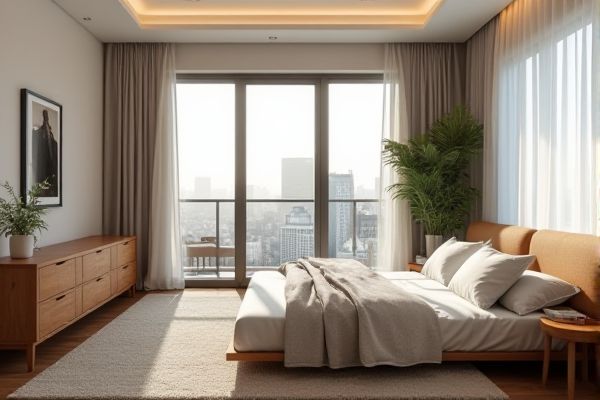
A daybed offers versatile seating and sleeping options with a more structured frame, often featuring a twin-size mattress suitable for daily use, while a futon provides a space-saving solution that easily converts from sofa to bed with a foldable mattress, ideal for small spaces. Explore the rest of the article to discover which option fits your lifestyle and space needs perfectly.
Table of Comparison
| Feature | Daybed | Futon |
|---|---|---|
| Primary Use | Seating and occasional sleeping | Convertible seating and bed |
| Structure | Frame with backrest and sides | Foldable mattress with wooden or metal frame |
| Comfort | Firm mattress, suitable for lounging | Varies; can be firm or soft based on mattress |
| Space Efficiency | Moderate; acts as sofa and bed | High; easily converts and often smaller footprint |
| Aesthetic | Classic, elegant design | Modern, functional design |
| Setup | Fixed frame, mattress stays in place | Folds and unfolds manually |
| Price Range | $200 - $1000+ | $150 - $800+ |
Introduction to Daybeds and Futons
Daybeds offer a versatile combination of seating and sleeping options with a frame typically designed like a twin-size bed, making them ideal for small spaces and guest rooms. Futons feature a foldable mattress on a wooden or metal frame that transforms easily from a couch to a bed, providing functionality and modern style in versatile living areas. Understanding the differences between daybeds and futons can help you select the best piece to suit your comfort needs and space constraints.
Key Differences Between Daybeds and Futons
Daybeds feature a twin-size mattress on a three-sided frame, offering a versatile seating area that doubles as a bed, while futons combine a foldable mattress and wooden or metal frame designed primarily for easy conversion between a sofa and a sleeping surface. Daybeds typically provide more structured back support, making them ideal for lounging during the day, whereas futons emphasize multifunctionality by effortlessly switching from sitting to lying positions. Understanding these key differences helps you choose the best option for your space, whether prioritizing daytime comfort or adaptable sleeping solutions.
Design and Aesthetic Comparison
Daybeds often feature a stylish frame that mimics traditional or modern sofa designs, making them versatile statement pieces in living rooms or guest areas. Futons typically have a minimalist, functional design with a mattress that folds directly onto the frame, emphasizing practicality over elaborate aesthetics. Your choice depends on whether you prioritize decorative appeal or a straightforward, space-saving solution.
Comfort and Sleeping Experience
Daybeds offer a firmer sleeping surface with a design similar to a twin mattress, providing consistent support ideal for back sleepers and short naps. Futons feature a foldable mattress that can vary in thickness and firmness, often resulting in a softer, more cushioned feel suitable for side sleepers but potentially less supportive over extended use. Choosing between the two depends on desired firmness, cushioning, and frequency of use as a primary sleeping solution.
Space-Saving Benefits
Daybeds provide versatile seating and sleeping options while occupying minimal floor space, making them ideal for small rooms and studio apartments. Futons offer dual functionality as both mattresses and sofas, easily folding to maximize usable space during the day. Both furniture pieces enhance space efficiency, with daybeds often featuring under-bed storage and futons prioritizing compact design for multi-purpose living areas.
Versatility and Functionality
Daybeds offer versatile seating and sleeping options ideal for small spaces, easily converting from a sofa to a twin-size bed with added under-bed storage for enhanced functionality. Futons combine a mattress and sofa frame, quickly transforming between couch and bed, providing practical use for guest rooms or lounges. Both pieces maximize space efficiency, but daybeds often feature more substantial frame designs and added storage, increasing their multifunctional appeal.
Durability and Maintenance
Daybeds typically offer higher durability due to their sturdy wooden or metal frames designed to support regular use, requiring minimal maintenance beyond occasional cleaning and tightening of screws. Futons, while versatile with foldable frames, may experience quicker wear and tear on both the mattress and mechanism, necessitating more frequent upkeep such as rotating the mattress and checking the frame's stability. Your choice between a daybed and a futon should consider the expected frequency of use and your willingness to maintain the piece to ensure long-lasting comfort and functionality.
Price Range and Affordability
Daybeds typically range from $200 to $800, offering a variety of styles that can suit different budgets while providing both seating and sleeping options. Futons generally fall within a more affordable price range of $150 to $500, making them an excellent choice for budget-conscious buyers seeking versatile furniture. Your decision on price and affordability should consider the multifunctionality and space-saving features offered by each option.
Best Use Cases for Daybeds and Futons
Daybeds are ideal for creating a versatile seating area that doubles as a guest bed in small living rooms or home offices, offering both style and comfort. Futons work best in flexible spaces like dorm rooms or apartments where a quick transformation between a sofa and a bed is essential for maximizing functionality. Your choice depends on whether you prioritize a permanent lounging spot or a compact, multi-use sleeping solution.
Which is Better: Daybed or Futon?
A daybed offers a more structured design with a twin-sized mattress ideal for both seating and sleeping, making it perfect for small spaces that require dual functionality. Futons provide versatility by easily folding from a sofa into a bed, maximizing comfort with thicker cushions but often compromise on mattress support and durability. Choosing between a daybed and futon depends on your need for sturdiness and daily use frequency versus flexible seating that converts quickly into a sleeping area.
 homyna.com
homyna.com